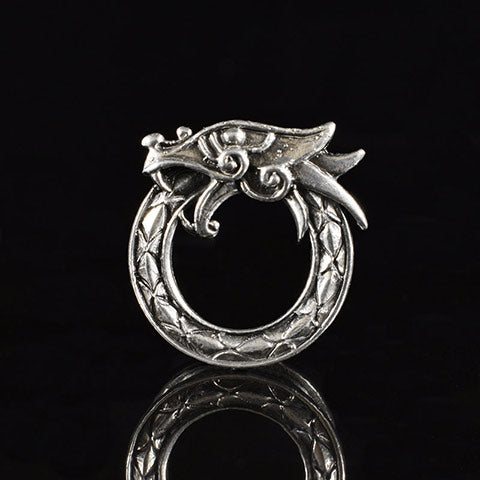The word "uroboros" or "ouroboros" has its origins in ancient Greek terms. It is made up of two Greek words:
"Oura" which means "tail" in ancient Greek.
"Boros" which means "eat" in ancient Greek.
Therefore, “ouroboros" is translated as "that which eats its tail."
The Ouroboros isn’t originally a Greek symbol though. It’s older than that. It has appeared in many different forms all over the world in many different cultures throughout human history but always with the same meaning. Sometimes a snake, sometimes a dragon. It's about the cycle of death and rebirth. In the never-ending circle of infinity, the end is a beginning and the beginning is an end.

The oldest-known ouroboros is found in the tomb of Tutankhamen in Egypt. According to Egyptologists the symbol “refers to the mystery of cyclical time, which flows back into itself”. The ancient Egyptians thought of time as a series of infinite repetitive cycles, not something linear and progressing as we do. The end of the year is the beginning of the year and the end of time is the beginning of time.
The ancient Greek philosopher Plato said he believed the ouroboros was the symbol of the ultimate perfect being that needed nothing but itself to survive because everything in existence resided within it and it itself fed on itself, it was the creator and destroyer all in one being.

In ancient Rome the symbol signified infinity. The symbol was associated with the god Saturn who ruled time and the passing of the seasons. Saturn was believed to connect one year to the next in a never-ending cycle that made up all eternity.

The ouroboros was also of significance to the Gnostics, the opposing ends of the ouroboros were interpreted as the divine and earthly in man, which, despite being at odds with one another, existed in unison nonetheless. In this sense, it is comparable to the Chinese yin and yang, depicting the harmony of contrary forces. Ouroboros expresses the unity of all things, material and spiritual, which never disappear but perpetually change form in an eternal cycle of destruction and re-creation.
The ouroboros also appears in other ancient traditions. In Norse mythology, the serpent Jörmungandr encircles the world with its tail in its mouth. In Hinduism, the ouroboros forms the foundation upon which the Earth rests.

Its interesting to see such an ancient symbol representing the same idea throughout history but an idea which at first glance might seem naïve and at odds with our recent enlightened scientific thinking. However, Roger Penrose the renowned mathematician and physicist seems to have resurrected the idea of the Ouroborus with his idea of ‘cyclic cosmology’
It suggests that the current state of our universe is merely one of perhaps an infinite number of cyclical universes. Penrose said; "I claim that this aeon is one of a succession of such things, where the remote future of the previous aeons somehow becomes the Big Bang of our aeon."
So maybe the ancients were somehow right all along!
https://en.wikipedia.org/wiki/Conformal_cyclic_cosmology
Rebirth and Eternal Cycle: The ouroboros symbolizes the idea of an eternal cycle of life, death and rebirth. It represents the notion that life and energy never completely die, but are constantly transformed and renewed in an infinite cycle.
Union of Opposites: The ouroboros can also represent the union of opposites, such as yin and yang in Chinese philosophy. By showing a snake eating its own tail, the symbol suggests that opposite extremes are connected and cannot exist without each other.
We have some jewellery which depict the Ouroboros.
Ouroboros Earrings
and
Ouroboros Ear Tunnels depicting the serpent Jörmungandr








